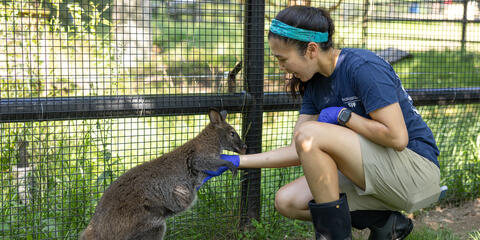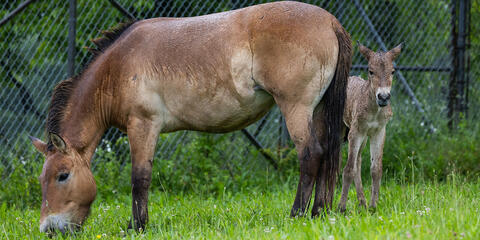Physical Description
Sitatunga have a slightly hunched appearance, with hind legs growing longer than forequarters. Adult males feature impressive spiraled horns that will be ivory tipped when fully developed. Color varies depending upon location and each individual. Males are traditionally a chocolate or gray-brown, while females are brown to bright chestnut in color. Adults will have a longer coat and white markings on the face, ears, body, legs and feet. Juveniles will have a woollier coat, with white spots and stripes on a bright red-brown coat.
Size
Sitatunga grow to 57 inches (115 centimeters) in length for females and 63 inches (160 centimeters) in males. Adult individuals can weigh between 110 and 275 pounds (50 to 125 kilograms),
Native Habitat
Sitatunga reside in the swamps, savannas, forests and forest clearings of central, eastern and parts of southern Africa, ranging from Cameroon and Central African Republic in the north to northern Botswana in the south. It is theorized that sitatunga likely occurred alongside waterways throughout western and central Africa as well, but are no longer found in that region.
Sitatunga prefer habitat complete with tall, dense vegetation, gravitating towards seasonal swamps, marshy clearings and thickets, but avoiding vegetation-free open water. Environments abundant with papyrus and reed stands are an optimal habitat for sitatunga as both a food source and a means of protection.
Lifespan
Lifespan for sitatunga is around 22 years in human care, but unknown in the wild.
Food/Eating Habits
As they spend the majority of their time in the water, sitatunga graze on young papyrus and reed shoots for the bulk of their diet. They forage both in the swamp and on land. They also consume flowers, buds, seeds, tall grasses and other foliage for nourishment, as well as occasionally feeding on elephant dung in order to receive nutrition from undigested seeds. Sitatunga may stand on their hind legs to reach higher vegetation, and males have been known to use their horns to break off branches for food. They have also been spotted grazing on crops at night.
Sitatunga at the Smithsonian's National Zoo have a diet comprised of herbivore pellets, alfalfa hay, orchard grass hay and woody browse.
Sleep Habits
Sitatunga spend the hottest parts of the day resting in the shade of reeds on platforms of dried vegetation, which they build themselves by trampling and circling on vegetation. If seriously alarmed, sitatunga sink below water to swim to deeper areas with only their nostrils above the surface. They will feed in cooler hours (or whenever they feel protected) and leave the water at night, returning before daybreak.
Social Structure
Sitatunga usually graze on their own, but they may also group in male/female pairs, bachelor groups of three or four, or family groups of five to 15 (comprising one bull, multiple ewes and juveniles).
Reproduction and Development
Sitatunga breed throughout the year, with females producing a single young after an approximately seven month gestation period. The calf will weigh 8 to 9 pounds (3.5 to 4 kilograms) at birth, and potentially double in weight during its first month. After the calf is born, the female hides it on a vegetation platform secluded in dry reeds, and in deep water for protection. Calves stay with their mothers for several months, learning to navigate the swamp safely. Sexual maturity is reached at approximately 1 year for females and 1.5 years for males.
Conservation Efforts
While sitatunga populations are considered abundant, their habitat is at risk as human development continues. Populations are thought to be decreasing in densely settled areas, but relatively stable elsewhere. As wetlands continue to be developed, population isolation presents an issue for the future of the species.
Sitatunga are also being hunted in increasing numbers as other sources of meat are becoming more difficult to find. As of 1999, about 40 percent of sitatunga resided in and around protected areas, but population stability is attributed more to low human interference than active conservation methods.
Help this Species
- Reduce, reuse and recycle — in that order! Cut back on single-use goods, and find creative ways to reuse products at the end of their life cycle. Choose recycling over trash when possible.
- Share the story of this animal with others. Simply raising awareness about this species can contribute to its overall protection.



